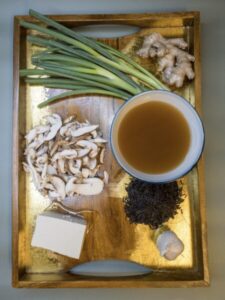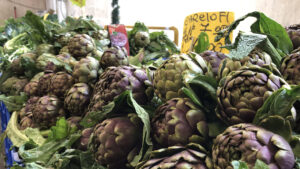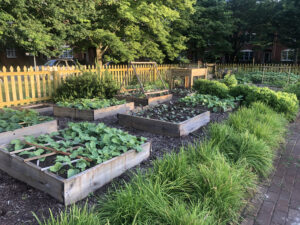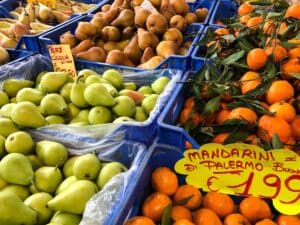Everyday choices, like what we eat for breakfast or buy at the grocery store, can impact our bodies, minds, and communities as well as potentially improve our health.
Join Audrey, a member of our Yoga District community, as she explores how food nourishes us. She will delve into the topic of conscious eating and consider how food can affect many aspects of our lives.
We can’t always make ideal food choices. This series will shed light on how we can approach food in a way that serves us individually. Also, it will offer guidance to those interested in incorporating or building conscious eating habits into their daily routines.
What Is Conscious Eating?
 For some of us, eating has become a routine activity we don’t think much about. We have three meals planned (give or take). We may find ourselves rushing out the door without time to fully savor our meals.
For some of us, eating has become a routine activity we don’t think much about. We have three meals planned (give or take). We may find ourselves rushing out the door without time to fully savor our meals.
Conscious eating is a practice that extends from the philosophy of mindfulness. Mindfulness encourages us to pay attention to the present and to accept our thoughts without judgment (1). Similarly, conscious eating is driven by a non-judgmental, individual experience of food (2). It is a practice that focuses on cultivating experiences that allow us to appreciate the food that nourishes us.
Conscious eating considers food in the present moment. Also, its prior stages such as how we choose, prepare, and serve food. It helps us understand where our food comes from and how it’s made. Plus, how our choices affect us internally and externally (3).
Yogic Values of Food
How we nourish ourselves plays a significant role in serving our yoga practice. In Taittiriya Upanishad, the five koshas, or sheaths, make up an individual (4). The first kosha, Annamaya kosha, translates to “consisting of food.” This is the outermost layer that nourishes the physical body but also supports the inner koshas (5). Through awareness of foods we consume and their effects on our bodies, we can fuel ourselves in a way that benefits us more than just physically.
With conscious eating habits, we can also practice the first niyama, saucha, which means purity (6). Pay attention to what we eat and how we approach food. Thereby further striving for cleanliness and purity in our environments. We can become more aware of what foods we consume. Examine how they make us feel and choose food that better serves us.
Upcoming Topics
Navigating Food Labels
Shopping for groceries can be overwhelming. Even if we need to pick up one thing, we are often faced with a decision of whether to grab the organic, natural, or farm raised item. We may also find ourselves trying to decipher food labels to compare different versions of the same item. In this blog post, we’ll explore food labels – what they mean and how they can impact our everyday grocery runs.
Seasonal Eating
 As the seasons change, we may notice a shift in what is available at our local farmer’s market. By using the seasons to guide what we eat, we can reap nutritional benefits and support our local communities (7). In this blog post, we’ll look into what seasonal eating is and learn about its benefits on a personal and community level. We’ll also look into what foods are available each season and offer guidance on how to make seasonal food choices.
As the seasons change, we may notice a shift in what is available at our local farmer’s market. By using the seasons to guide what we eat, we can reap nutritional benefits and support our local communities (7). In this blog post, we’ll look into what seasonal eating is and learn about its benefits on a personal and community level. We’ll also look into what foods are available each season and offer guidance on how to make seasonal food choices.
Where does our food come from?
Understanding where our food comes from can help us improve our approach and decisions around food. Potentially providing benefit to our communities (8). In this blog post, we will explore the nutritional and environmental benefits of knowing where our food comes from. We will also delve into some of the environmental implications of food transport and supply. Plus, offer guidance on how to source food locally.
Sources:
- Mindfulness meditation: A research-proven way to reduce stress, https://www.apa.org/topics/mindfulness/meditation
- Mindful Eating: The Art of Presence While You Eat, https://www.ncbi.nlm.nih.gov/pmc/articles/PMC5556586/
- Mindful eating, https://www.health.harvard.edu/staying-healthy/mindful-eating
- The Koshas: 5 Layers of Being, https://yogainternational.com/article/view/the-koshas-5-layers-of-being/
- Annamaya Kosha, https://www.yogapedia.com/definition/5889/annamaya-kosha
- The First Niyama: Saucha, https://www.yogauonline.com/yoga-basics/first-niyama-saucha
- Why Eat Seasonally?, https://www.seasonalfoodguide.org/why-eat-seasonally
- Know Where Your Food Comes From with USDA Foods, https://www.usda.gov/media/blog/2016/05/25/know-where-your-food-comes-usda-foods


